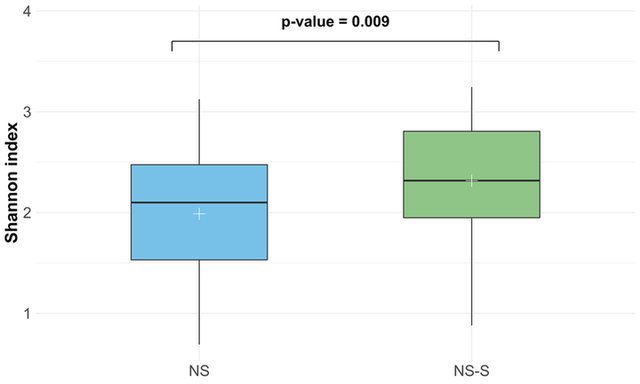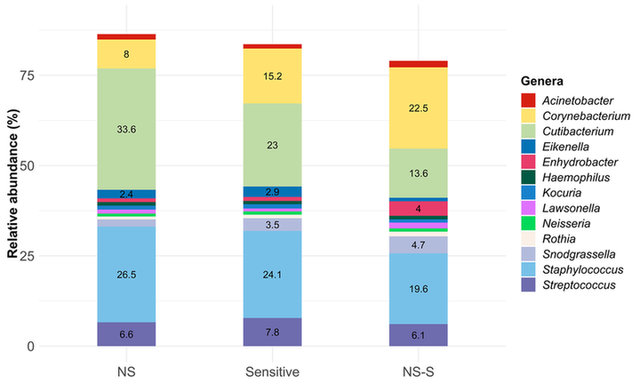SENSITIVE SKINS
WEAR THEIR OWN
SKIN MICROBIOTA
MICROBIOME

Even if we cannot see them, microorganisms are everywhere in nature and they are adapted to all kinds of conditions from the deepest ocean to the highest mountain. Human skin is “just” another environment and this niche is obviously colonised by microorganisms. If we consider the body of a 70 kg adult, microorganisms are estimated to be as numerous as the human cells that make up this body. All these microorganisms form the so-called skin microbiota, encompassing several hundred species of bacteria, fungi, viruses and even mites. Although controversial, some studies have shown that even foetuses are not free of microbes. Nonetheless, newborn skin is quickly colonised by either the vaginal microbiota or the skin microbiota of the mother, depending on the mode of delivery. The skin microbiota changes a lot during the first years of life to become more stable and site specific in adults. During the first stage of life, the human host and the microbiota evolve together in a mutualistic way of life. The skin microbiota educates the immune system, allowing the immune system to tolerate commensal bacteria and to eliminate pathogenic bacteria. Furthermore, these commensal bacteria are essential, e.g. in maintaining a low pH (that is good for the skin per se) and then inhibiting the development of pathogenic microorganisms. Some of these bacteria also produce different antimicrobial peptides or even anti-oxidant enzymes. Skin microbiota and human skin cells thus work together to ensure the healthy status of our skin. Unfortunately, this teamwork sometimes fails and several skin conditions are known to be triggered or to worsen due to the modification of the skin microbiota (acne, dermatitis atopic, lupus, etc.). In other words, human skin is the seat of strong competition and collaboration between microorganisms and human cells, and the health of human skin relies on the balance of these relations.
SKIN MICROBIOTA INTRODUCTION
Aging is associated with a significant skin evolution, in terms of functions (decrease in sebum production, decrease in hydration levels, more permissive immune system, etc.) and structure (decrease in collagen production, thinning of the epidermis, etc.). These modifications induce a change in living conditions for the microorganisms inhabiting our skin, which may trigger an evolution of the skin microbiota. Using Next Generation Sequencing methods, we compared the skin microbiota of two groups of women without skin disorders. The NS group comprises 61 women aged between 23 and 50 years old (mean = 36.0), and the NS-S group comprises 23 older women (aged between 51 and 69 years old [mean = 59.2]). Thanks to this study, we confirmed (as previously reported) that aging is associated with:
an increase in the diversity of skin microbiota (Figure 1);
a significant evolution in the proportion of the most abundant skin genera: decrease in Cutibacterium (from 33.6% to 13.6%) and Staphylococcus (from 26.5% to 19.6%) genera; increase in Corynebacterium genus (from 8.0% to 22.5%).
Among the former genera, several species are regarded as symbiotic microorganisms thanks to their ability to protect the skin against pathogen colonisation and environmental pressure.
On the other hand, several bacteria among the Corynebacterium genus are known to have pro-inflammatory activities. Although it is unknown whether the evolution of the skin microbiota with aging is a cause or a consequence of the skin modifications described earlier, the skin microbiota drift observed during aging cannot be considered as beneficial, and in our point of view, contributes to a vicious circle promoting the evolution of skin with aging. For these reasons, active cosmetic ingredients (such as Vetivyne™) that are able to act on the modification of skin functions observed during aging and also protect the skin microbiota are of great interest; this kind of active ingredient breaks the vicious circle relating to the drift of the skin microbiota during aging.
SKIN MICROBIOTA AND AGING

Figure 1. Skin microbiota diversity for NS and Sensitive groups. Shannon index for the two classes of age: Shannon index can be considered as a proxy to illustrate how many different kinds of bacteria are present in the microbiota and how these bacteria are distributed. A high number of different bacteria leads to a high Shannon index; for two communities with the same number of different bacteria, the most balanced community (balanced proportions of the different bacteria) will have the highest Shannon index. NS = non-sensitive skin group (61 women, mean age 36.0); Sensitive = sensitive skin group (44 women, mean age 37.4).
JARRIN CYRILLE et al.*
Givaudan France SAS, Active Beauty | France

Bio...
Cyrille Jarrin achieved a Ph.D. in Microbial and Molecular Ecology in the Université Claude Bernard Lyon I (France) in 2005. His story with Givaudan France (Acive Beauty division) began when he did multidisciplinary work for his Ph.D at LibraGen, one of Active Beauty’s predecessors. Thereafter he evolved towards the role of sequencing and data analysis project manager, further supervising various projects in the fields of microbiological exploration and skin microbiota research.

Sensitive skin syndrome is a multifactorial skin disorder described as “the occurrence of unpleasant sensations (…) in response to stimuli which normally should not provoke such sensation”. This syndrome is a worldwide issue impacting more and more people (60-70% of women and 50-60% of men). In some conditions this syndrome shares some “symptoms” with aging (inflammation, immune system modification, etc.). This is why during the study on the skin microbiota described in the former paragraphs we also studied the skin microbiota of 44 women with sensitive skin (based on the adverse sensory response to the capsaicin test), aged between 20 and 50 (mean = 37.42 –Sensitive group). The aim was first to compare the skin microbiota of women with and without sensitive skin, taking into account women of the same class of age (mean age 36.0 and 37.42, for NS and Sensitive groups respectively). The second objective was to compare the skin microbiota of women with sensitive skin to the skin microbiota of older women without sensitive skin (Sensitive versus NS-S groups).
Considering women of same age, a slight increase in the diversity (Shannon index) of sensitive skin microbiota was observed. Regarding the most abundant genera (Figure 2), a significantly lower proportion of the Cutibacterium genus was reported on sensitive skin (33.6% vs. 23.0% on non-sensitive (NS) and sensitive skin, respectively). In addition, the proportion of Corynebacterium almost doubled on sensitive skin (8.0% vs. 15.2% on non-sensitive (NS) and sensitive skin respectively), whereas the Staphylococcus genus abundance remained stable. Sensitive skin displays a specific microbiota composition significantly different to that of non-sensitive skin, regardless of the age of the women. Furthermore, as reported with aging, a decrease in beneficial bacteria, e.g. the bacteria belonging to the Cutibacterium genus, and an increase in pro-inflammatory bacteria, e.g. bacteria belonging to the Corynebacterim genus, is observed on sensitive skin. This kind of skin microbiota drift could aggravate sensitive skin syndrome, and be part of the vicious circle related to this syndrome.
It is clearly apparent that sensitive skin has an intermediate microbiota in terms of diversity and composition (Figure 2). This central position of the sensitive skin microbiota between skin microbiota without sensitive skin below and above 50 years old leads us to associate sensitive skin syndrome with a premature ageing of the skin.
SKIN MICROBIOTA AND SENSITIVE SKIN SYNDROME

Figure 2. Skin microbiota composition at genus level for NS, Sensitive and NS-S groups (genera > 0.70 %). NS = non-sensitive skin group (61 women, mean age 36.0); Sensitive = sensitive skin group (44 women, mean age 37.4); NS-S = non-sensitive skin senior group (23 women, mean age 59.2).
Finally, women with sensitive skin were enrolled in a double blind and placebo controlled clinical study. The cohort was split into two groups that had to apply a formula on their faces containing either an extract of the micro-algae Phaeodactylum tricornutum at 3% or a placebo, twice a day for 28 days. This extract called Sensityl™ was selected on the basis of its in-vitro activities: inhibition of immune cell recruitment and transmigration, reduction of pro-inflammatory signal (IL-8 inhibition), reduction of pain sensation (TRPV1 expression) and control of microbial proliferation (β-Defensin 2 release). During the clinical test a clear improvement of sensitive skin syndrome was reported: compared to the placebo, Sensityl™ at 3% significantly reduces skin irritation and enables a significant improvement of skin reactivity. Moreover, regarding skin microbiota composition, Sensityl™ at 3% provides a protective effect by stabilising:
the diversity of sensitive skin microbiota;
the relative abundance of the Firmicutes phylum (Table 1) and the Cutibacterium genus.
The active application also leads to:
a significant increase in the relative abundance of the Actinobacteria phylum (Table 1)
a significant decrease in the Corynebacterium genus proportion.
Thus, thanks to the application of 3% Sensityl™, the skin microbiota of sensitive skin partly converges toward a microbiota of non-sensitive skin.
Thanks to a non-verbal neuroscience method designed to measure consumers’ moods and emotional responses to various stimuli, it was then proven that Sensityl™ is very effective emotionally, as it evokes a significantly higher number of positive emotions and significantly lower number of negative emotions than the placebo. Additionally, Sensityl™ application has generated a wider range of positive emotions, such as: sensuality, protection, happiness, appeasement and fortitude, than the placebo.
SENSITIVE SKIN SYNDROME ALLEVIATION

Table 1. Skin microbiota evolution after 14 days of treatment (#p-value < 0.1; *p-value < 0.05).
Thanks to a DNA sequencing approach it was possible to demonstrate that sensitive skin has its own microbiota composition. The microbiota of sensitive skin shares several features with the skin microbiota of aged skin, regarding the diversity and the abundance of major bacteria. These common points could explain the existence of similar disorders between old skin and sensitive skin (e.g. dryness, impaired skin barrier function or inflammation status). Thus sensitive skin could be associated with premature ageing of the skin. Finally, we showed that the application of the active ingredient Sensityl™ leads to an alleviation of the syndrome, by acting on the different manifestations of sensitive skin syndrome: inflammation, skin reactivity, skin irritation and skin microbiota composition. As a consequence, it even acts on improving people’ moods.
* JARRIN CYRILLE, SCANDOLERA AMANDINE, HUMEAU ANNE, SHAN GODBILLE, REYNAUD ROMAIN
Givaudan France SAS, Active Beauty | France



